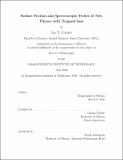Surface Friction and Spectroscopic Probes of New Physics with Trapped Ions
Author(s)
Counts, Ian T.
DownloadThesis PDF (16.03Mb)
Advisor
Vuletić, Vladan
Terms of use
Metadata
Show full item recordAbstract
To trap a single ion under vacuum is to control a microscopic, isolated quantum laboratory. This thesis describes two research programs made possible by single-ion trapping of Yb⁺. The first program is a study of a paradigmatic frictional interface: a trapped ion transported along a one-dimensional multistable energy landscape formed by a periodic, corrugated optical potential and a harmonic electric trapping potential. Two regimes of friction behavior are differentiated: single-slip (whereby an ion slips out of a corrugated groove and sticks into its neighboring groove) versus multislip (whereby the ion instead sticks into its next-neighboring or next-next-neighboring groove). By varying transport speed and corrugation depth, experimental signatures of both regimes are measured and used to write a predictive Boltzmann model. At low enough corrugations, the ion can be expected to tunnel through (in addition to slip over) the potential barriers of the energy landscape, leading to a reduction in friction termed quantum lubricity. Attempts at seeing quantum tunneling via static Rabi oscillations are described. While no smoking-gun signature of tunneling was repeatable, the suppression of quantum tunneling behavior is attributed to certain technical limitations of the experiment apparatus, and possible remedies are considered. The second (and largest) research program of this thesis is a probe of new physics via isotope shift spectroscopy. Shift measurements are taken to sub-kHz precision across all five even-numbered isotopes of Yb+ along three clock transitions (quadrupolar shifts S₁/₂ → D₅/₂, S₁/₂ → D₃/₂, and octupolar shift S₁/₂ → F₇/₂). Deviations from theoretical predictions have been found and indicate higher-order Standard Model effects or even beyond-the-Standard-Model physics. Spectroscopic design and shift results, as well as possible theoretical conclusions, are discussed.
Date issued
2020-05Department
Massachusetts Institute of Technology. Department of PhysicsPublisher
Massachusetts Institute of Technology